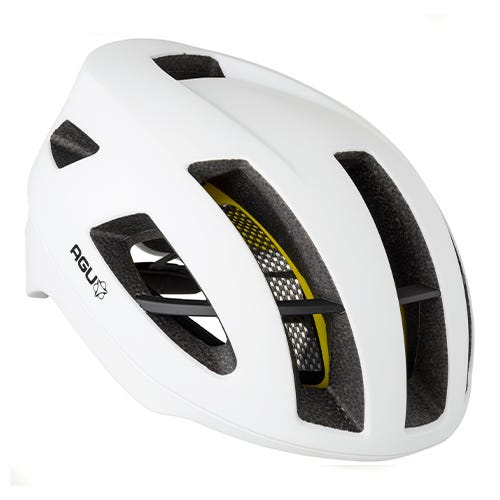The AGU bicycle helmet guide
Use your brain, wear a helmet!
Cycling helmets can prevent up to 80% of head injuries in severely injured people. Nevertheless, only the minority of all people wear a helmet when riding their bike. But why is this the case? Some of the most frequently cited reasons are the uncomfortable feeling when wearing a helmet and its unaesthetic appearance. But there are solutions for this! In this article we will tell you how to find the perfect helmet for you and which criteria the ideal helmet should meet...
#1 The cycling helmet must fit
A helmet that does not fit properly is uncomfortable and cannot reliably protect you in the event of a fall. To find the right helmet size, you need to measure the circumference of your head. This works best with a measuring tape. Place it about one centimetre above your eyebrows and measure around your head as straight as possible. The tape measure should fit your head just above your ears. You can find more detailed information about the sizes of AGU helmets on the product pages.


#2 The cycling helmet should meet the prescribed safety standards
When you buy a helmet, it should - like all AGU helmets do - meet the test standard DIN EN 1078.


#3 The bike helmet should match your bike style
Are you challenging yourself with your racing bike or are you rather the comfortable city cyclist?
As a sporty rider, your helmet should be particularly light, well ventilated and aerodynamic, just like our AGU Tesero helmet. With a total of 24 vents and a weight of just 199 grams, it is the perfect companion for fast tours.
For daily rides through the city, it may also be a slightly less sporty looking helmet. On the other hand, what is very useful for is an integrated rear light, like on our Urban Pedelec helmet.
#4 You should like the look of the helmet


If you don't like how your helmet looks, you will wear it less often - and thus not fulfill any protective function. Therefore, you should only buy a helmet whose appearance really convinces you and which suits you. Our Strato helmet, for example, is available in 4 nice colors - there should also be the right one for you!
MIPS - the smart helmet system
MIPS - short for "Multi Directional Impact Protection System" - is a safety system for helmets, which is intended to protect against impacts with different directions of movement or force. These different directions of force are generated by impacts that hit the helmet at an angle.
HOW DOES THE MIPS SYSTEM WORK?
The idea for the MIPS system comes from the human brain. To protect it, there is a fluid between the brain and the cranial bone. When the head is hit, the resulting rotational force is reduced by minimal movement of this fluid layer and the force is not transferred to the brain.
The MIPS is, so to speak, an imitation of this layer: The outer shell of the helmet is fitted with a movable second shell which lies directly against the head.
Discover the Vigarous helmet with integrated MIPS system.
Further useful information...
- After five to six years at the latest, helmets have reached their maximum service life and should be replaced.
- After a fall, the cycling helmet should be replaced immediately, as small micro-cracks may have appeared and invisibly damaged the helmet.
- The best place to store a helmet is as far away from heat sources as possible, as heat can cause the coating to peel off.
- AGU also has helmets for kids.
NEWSLETTER ABONNIEREN
Melde dich für unseren Newsletter an und bleib immer auf dem Laufenden.







